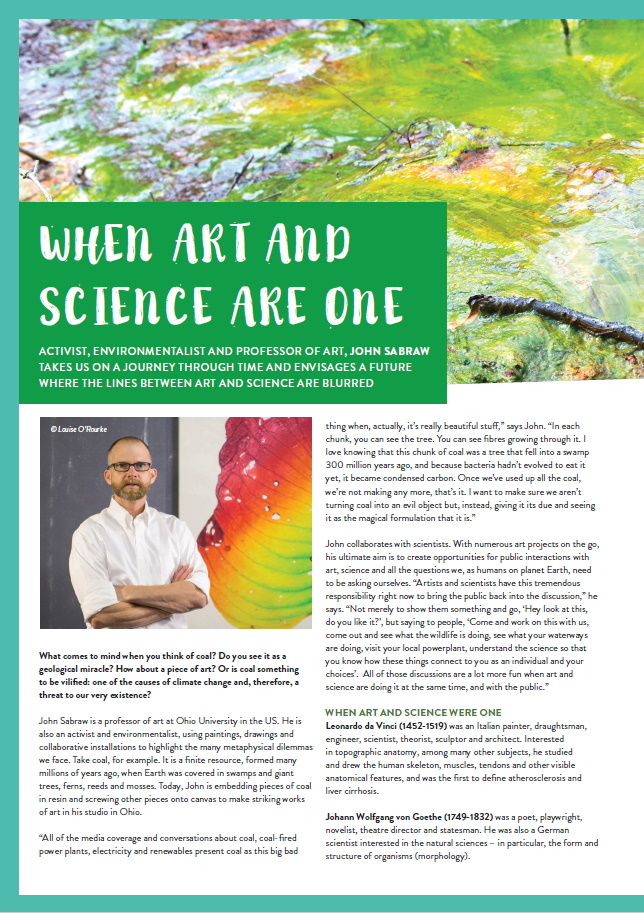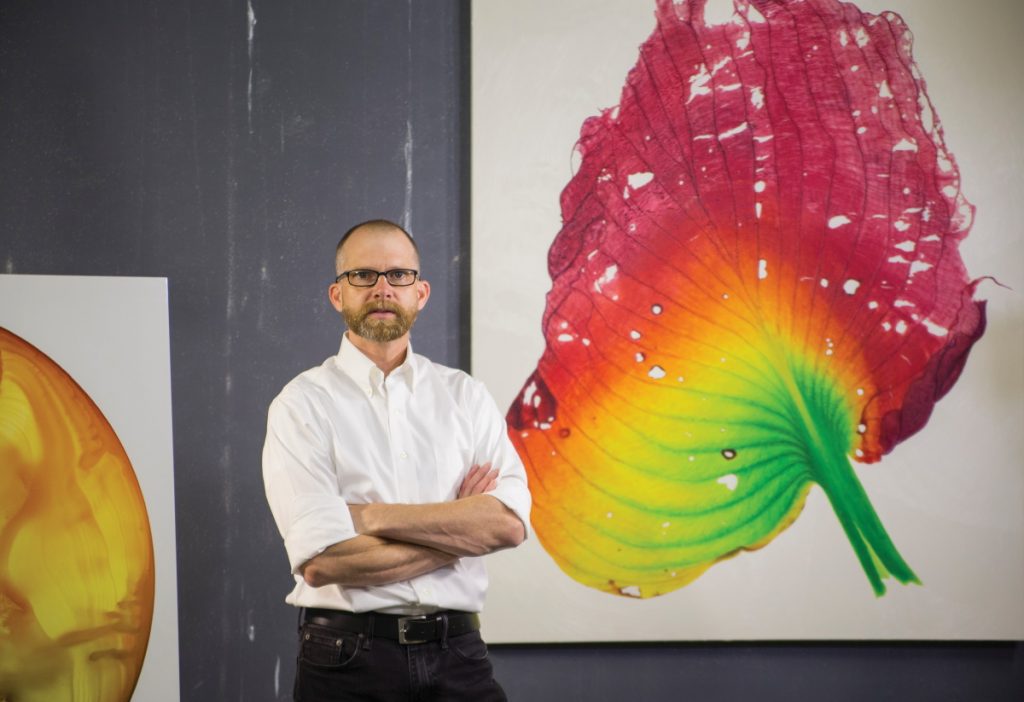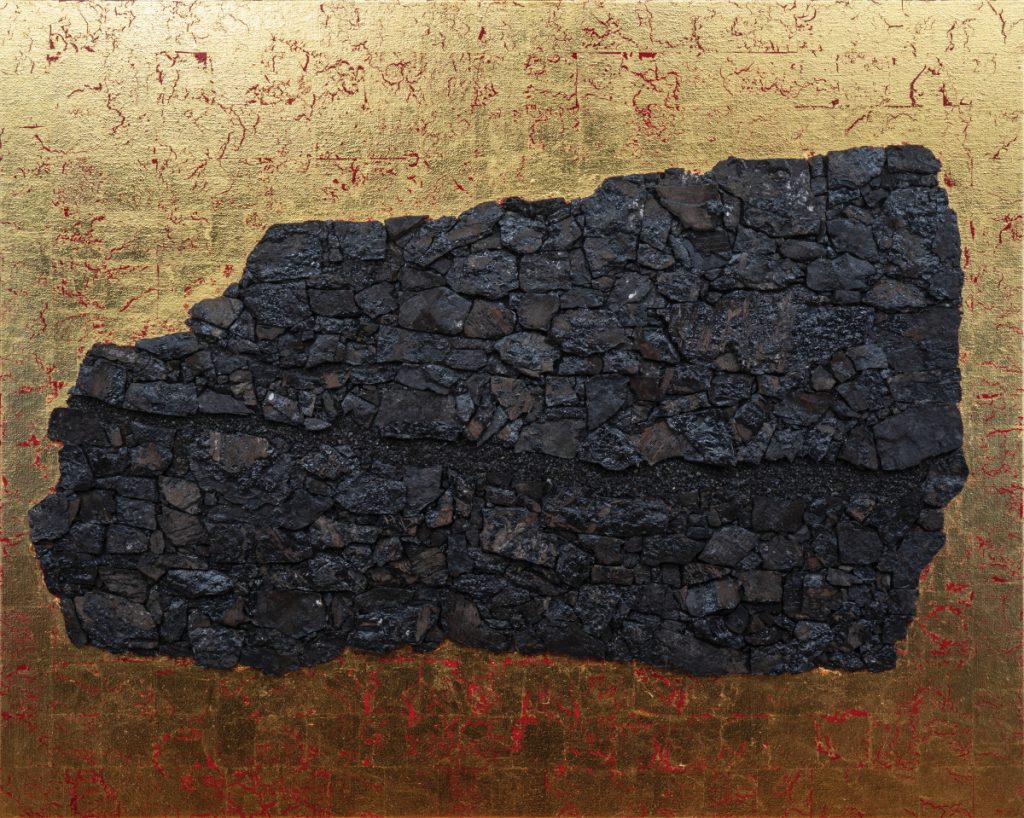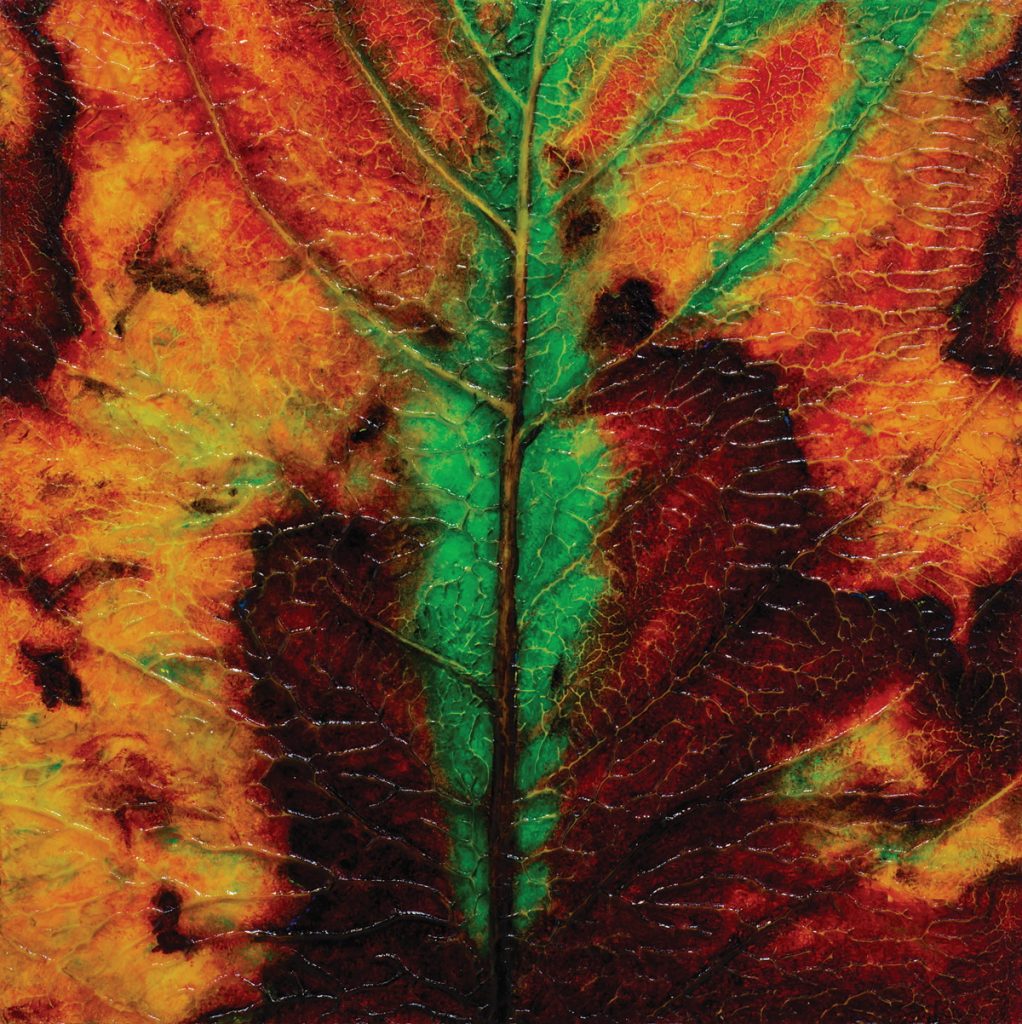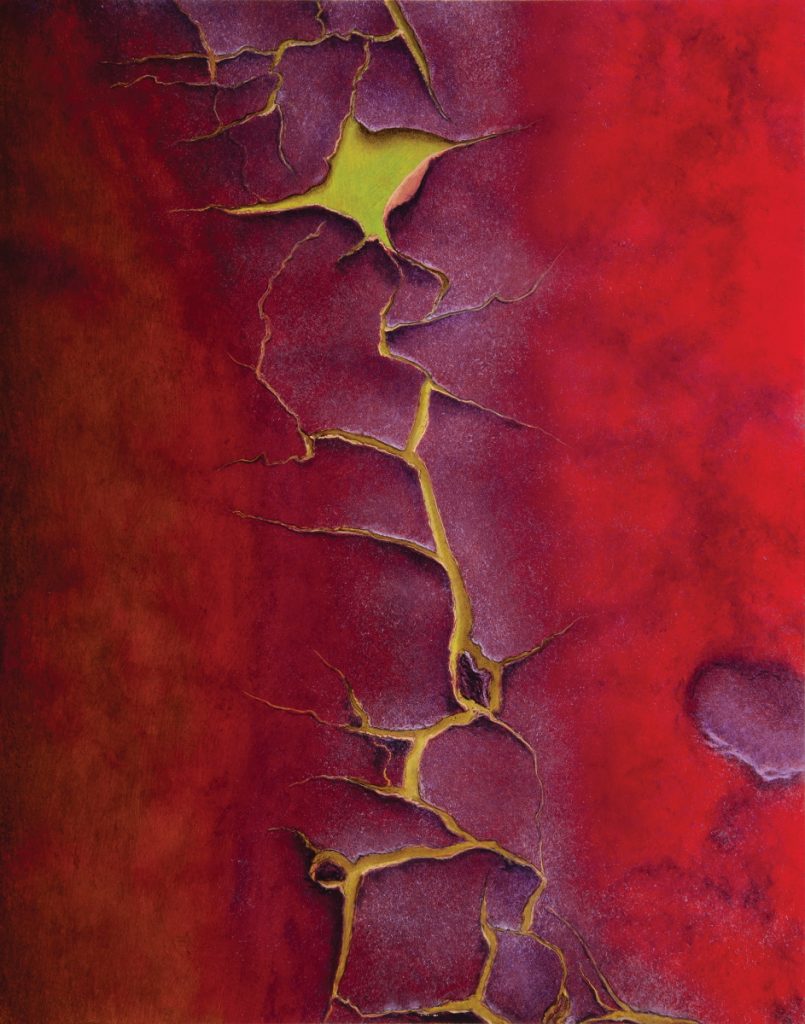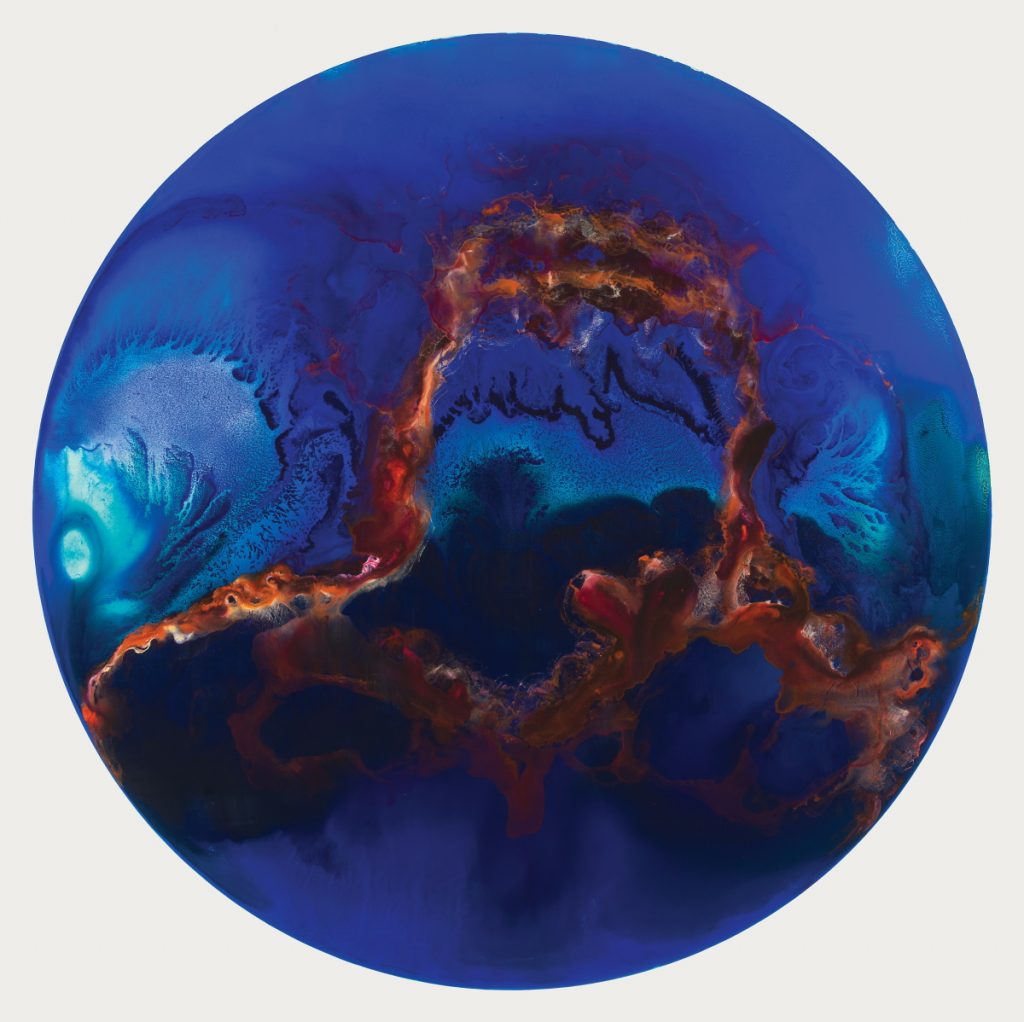John Sabraw: Environmentalist, activist and Professor of Art
Activist, environmentalist and professor of art John Sabraw takes us on a journey through time and envisages a future where the lines between art and science are blurred
What comes to mind when you think of coal? Do you see it as a geological miracle? How about a piece of art? Or is coal something to be vilified: one of the causes of climate change and therefore a threat to our very existence?
John Sabraw is a professor of art at Ohio University in the US. He is also an activist and environmentalist, using paintings, drawings and collaborative installations to highlight the many metaphysical dilemmas we face. Take coal, for example. It is a finite resource, formed many millions of years ago, when Earth was covered in swamps and giant trees, ferns, reeds and mosses. Today, John is embedding pieces of coal in resin and screwing other pieces onto canvas to make striking works of art in his studio in Ohio.
“All of the media coverage and conversations about coal, coal-fired power plants, electricity and renewables present coal as this big bad thing when, actually, it’s really beautiful stuff,” says John. “In each chunk, you can see the tree. You can see fibres growing through it. I love knowing that this chunk of coal was a tree that fell into a swamp 300 million years ago, and because bacteria hadn’t evolved to eat it yet, it became condensed carbon. Once we’ve used up all the coal, we’re not making any more, that’s it. I want to make sure we aren’t turning coal into an evil object but instead giving it its due and seeing it as the magical formulation that it is.”
John collaborates with scientists. With numerous art projects on the go, his ultimate aim is to create opportunities for public interactions with art, science and all the questions we, as humans on planet Earth, need to be asking ourselves. “Artists and scientists have this tremendous responsibility right now to bring the public back into the discussion,” he says. Not merely to show them something and go, ‘Hey look at this, do you like it?’, but saying to people, ‘Come and work on this with us, come out and see what the wildlife is doing, see what your waterways are doing, visit your local powerplant, understand the science so that you know how these things connect to you as an individual and your choices’. All of those discussions are a lot more fun when art and science are doing it at the same time, and with the public.”
WHEN ART AND SCIENCE WERE ONE
Leonardo da Vinci (1452-1519) was an Italian painter, draughtsman, engineer, scientist, theorist, sculptor and architect. Interested in topographic anatomy, among many other subjects, he studied and drew the human skeleton, muscles, tendons and other visible anatomical features, and was the first to define atherosclerosis and liver cirrhosis.
Johann Wolfgang von Goethe (1749-1832) was a poet, playwright, novelist, theatre director and statesman. He was also a German scientist interested in the natural sciences – in particular, the form and structure of organisms (morphology).
Alexander von Humboldt (1769-1859) was a German polymath, meaning his knowledge spanned a substantial number of subjects. His main interests, though, were in geography, the natural sciences, exploration and philosophy.
Art and science have not always been viewed as separate entities. Rather, art and science were seen as a vital and inseparable means of understanding and describing the world. Towards the end of the 19th Century, however, and far into the 20th Century, the two began to separate. ““When we had Goethe, Alexander von Humboldt and Leonardo, people understood that it was all connected. But then we made art and science irrelevant to the everyday lives of citizens,” says John. “In academia, specifically, we did a great job of making sure that art and science were removed from the public. We did a fantastic job of specialising, specialising and specialising. Towards the end of the 20th century, though, artists and scientists started to recognise that it’s not about making art or doing science in ivory towers.”
ART AND SCIENCE IN THE 20TH CENTURY
Agnes Denes (1931-) is a Hungarian-born American conceptual artist. Based in New York in the US, she is known for her works in a wide range of mediums, covering science, philosophy, linguistics, psychology, history and music. In 1982, Agnes planted a two-acre wheatfield on a landfill site in lower Manhattan. She wanted visitors to do more than simply observe her art; she wanted them to experience it. The wheat was harvested, sent to 28 cities around the world in an exhibition called International Art Show for the end of World Hunger, and the seeds handed out to people to plant. In an interview, Agnes said “Wheatfield – A Confrontation represented food, energy, commerce, world trade, economics. It referred to mismanagement, waste, world hunger and ecological concerns.”
Mel Chin (1951-) is another American conceptual artist motivated by political, cultural and social circumstances. Mel started investigating the use of hyperaccumulator plants – plants that are able to extract heavy metals like cadmium, zinc and nickel from contaminated soil – and, in 1991, began an ongoing project with Dr Rufus Chaney, a senior research agronomist at the US Department of Agriculture. Based at the former Pig’s Eye Landfill in Minnesota, Revival Field is a 60 x 60-foot square, with a circle delineated inside that has been divided into 96 plots. Pig’s Eye was a hazardous waste site classified as toxic to humans and the environment by the Environmental Protection Agency. Mel’s idea was to test the efficacy of different hyperaccumulator plants in removing heavy metals from this site. Through this project and others, Mel has been instrumental in redefining the concept of art and its role in society.
What comes to mind when you think of coal? Do you see it as a geological miracle? How about a piece of art? Or is coal something to be vilified: one of the causes of climate change and therefore a threat to our very existence?
John Sabraw is a professor of art at Ohio University in the US. He is also an activist and environmentalist, using paintings, drawings and collaborative installations to highlight the many metaphysical dilemmas we face. Take coal, for example. It is a finite resource, formed many millions of years ago, when Earth was covered in swamps and giant trees, ferns, reeds and mosses. Today, John is embedding pieces of coal in resin and screwing other pieces onto canvas to make striking works of art in his studio in Ohio.
“All of the media coverage and conversations about coal, coal-fired power plants, electricity and renewables present coal as this big bad thing when, actually, it’s really beautiful stuff,” says John. “In each chunk, you can see the tree. You can see fibres growing through it. I love knowing that this chunk of coal was a tree that fell into a swamp 300 million years ago, and because bacteria hadn’t evolved to eat it yet, it became condensed carbon. Once we’ve used up all the coal, we’re not making any more, that’s it. I want to make sure we aren’t turning coal into an evil object but instead giving it its due and seeing it as the magical formulation that it is.”
John collaborates with scientists. With numerous art projects on the go, his ultimate aim is to create opportunities for public interactions with art, science and all the questions we, as humans on planet Earth, need to be asking ourselves. “Artists and scientists have this tremendous responsibility right now to bring the public back into the discussion,” he says. Not merely to show them something and go, ‘Hey look at this, do you like it?’, but saying to people, ‘Come and work on this with us, come out and see what the wildlife is doing, see what your waterways are doing, visit your local powerplant, understand the science so that you know how these things connect to you as an individual and your choices’. All of those discussions are a lot more fun when art and science are doing it at the same time, and with the public.”
WHEN ART AND SCIENCE WERE ONE
Leonardo da Vinci (1452-1519) was an Italian painter, draughtsman, engineer, scientist, theorist, sculptor and architect. Interested in topographic anatomy, among many other subjects, he studied and drew the human skeleton, muscles, tendons and other visible anatomical features, and was the first to define atherosclerosis and liver cirrhosis.
Johann Wolfgang von Goethe (1749-1832) was a poet, playwright, novelist, theatre director and statesman. He was also a German scientist interested in the natural sciences – in particular, the form and structure of organisms (morphology).
Alexander von Humboldt (1769-1859) was a German polymath, meaning his knowledge spanned a substantial number of subjects. His main interests, though, were in geography, the natural sciences, exploration and philosophy.
Art and science have not always been viewed as separate entities. Rather, art and science were seen as a vital and inseparable means of understanding and describing the world. Towards the end of the 19th Century, however, and far into the 20th Century, the two began to separate. ““When we had Goethe, Alexander von Humboldt and Leonardo, people understood that it was all connected. But then we made art and science irrelevant to the everyday lives of citizens,” says John. “In academia, specifically, we did a great job of making sure that art and science were removed from the public. We did a fantastic job of specialising, specialising and specialising. Towards the end of the 20th century, though, artists and scientists started to recognise that it’s not about making art or doing science in ivory towers.”
ART AND SCIENCE IN THE 20TH CENTURY
Agnes Denes (1931-) is a Hungarian-born American conceptual artist. Based in New York in the US, she is known for her works in a wide range of mediums, covering science, philosophy, linguistics, psychology, history and music. In 1982, Agnes planted a two-acre wheatfield on a landfill site in lower Manhattan. She wanted visitors to do more than simply observe her art; she wanted them to experience it. The wheat was harvested, sent to 28 cities around the world in an exhibition called International Art Show for the end of World Hunger, and the seeds handed out to people to plant. In an interview, Agnes said “Wheatfield – A Confrontation represented food, energy, commerce, world trade, economics. It referred to mismanagement, waste, world hunger and ecological concerns.”
Mel Chin (1951-) is another American conceptual artist motivated by political, cultural and social circumstances. Mel started investigating the use of hyperaccumulator plants – plants that are able to extract heavy metals like cadmium, zinc and nickel from contaminated soil – and, in 1991, began an ongoing project with Dr Rufus Chaney, a senior research agronomist at the US Department of Agriculture. Based at the former Pig’s Eye Landfill in Minnesota, Revival Field is a 60 x 60-foot square, with a circle delineated inside that has been divided into 96 plots. Pig’s Eye was a hazardous waste site classified as toxic to humans and the environment by the Environmental Protection Agency. Mel’s idea was to test the efficacy of different hyperaccumulator plants in removing heavy metals from this site. Through this project and others, Mel has been instrumental in redefining the concept of art and its role in society.
“From around the 70s, artists like Robert Smithson were doing art about environmental degradation, but even though the dialogue was here, little of it was directly involved with scientists,” says John. “They weren’t citizen science projects that people could interact with. When you get to the early 80s, Agnes and Mel started doing this work. This is when you begin to see a shift in terms of inspiring artists and scientists to collab in this way.”
ART AND SCIENCE IN THE FUTURE
Periscopic calls itself a ‘socially conscious data visualisation firm’ and its motto is ‘Do Good With Data’. Periscopic is driven by artists (or artisans, as they call themselves) and their aim is to help organisations promote data transparency and public awareness. Their work spans all manner of societal issues, such as helping people empathise with children living in urban poverty, revealing the overwhelming magnitude of loss from US gun deaths, or raising awareness about breast cancer risk in the workplace. Periscopic is an example of an organisation that’s blurring the lines between what we would normally define as art or science.
“What I’m seeing now gives me great hope for the near future,” says John. “It’s not just about two disciplines working side by side in a space, it’s about people creating something new from collaborations. I’m seeing it in terms of people who are dealing with gender issues, racial issues and inequality, as well as environmental issues. I’m seeing scientists, anthropologists, sociologists and psychologists working with artists to start addressing issues in a more public way. And I’m seeing a lot of cool artists who are crossing over into coding, Processing, Unity and things like that. They’re visualising data in ways that mathematicians or scientists can’t and they’re making new discoveries. Now we’re asking: What is design, what is art, what is data, what is science, and what is the public outreach? It’s all becoming a little blurry and I like it.”
In these current times, there is still a tendency to separate the arts and sciences and to see ourselves as either an artist or scientist. Is this really the right way to be looking at the world around us and solving the challenges that need to be solved? Or should we be drawing on our collective creativity and knowledge, and working together to safeguard the natural wonders of our planet?
ABOUT JOHN
John was born in St Ives, Cornwall in UK, before moving to Southern Idaho in the US as a young boy when his father was reassigned to Mountain Home Airforce Base. Much of John’s childhood was spent outdoors, exploring the canyons and desert landscapes, camping next to lakes where grizzlies roamed, and catching trout to cook over open fires. John loved drawing, and was good at it, but he didn’t know he could embark on a career as an artist. He also loved science, but not as a school subject. He liked catching grasshoppers, reading books about prospecting for precious metals, and making explosives. Eventually, his explosives got him into trouble, and he was offered counselling or the justice system. John chose counselling. Interestingly, he was sent to a chemistry professor, Carl Bricker, who opened John’s world to chemistry and more. “It became less about chemistry and more about the cosmos and how it works and what our place is in it,” says John. “And that is the core of who I am today, without question.”
JOHN’S WORK
John has many collaborations with scientists on the go. One such project involves cleaning up waterways in Ohio that have been ravaged by coalmining. He and his team collect toxic sludge from polluted streams, extract iron oxide from the sludge, and turn it into iron oxide pigment, which is then used to make paint.
You can read more about the project here: www.johnsabraw.com/research
Another example is a project with Draper Lab and MIT (Massachusetts Institute of Technology). “They’re figuring out ways to take Monterey pine, which is an endangered species in California, and grow wood fibres in the lab so that you don’t have to cut down trees to make paper,” explains John. The team at Draper Lab and MIT are sending wood fibres to John, who will turn them into artwork that will inspire the public to learn more and get involved.
“Whoever you are, whatever you’re doing at any point in your life, it’s good enough. All those things you desire, which might come to you someday but aren’t in your life at the moment, those things can make you feel like you’re not good enough. You are without question good enough. No matter how young you are, if you have something you’re skilled at – coding, artwork, design, outreach – find someone who’s doing something that speaks to you, reach out to them, email them, text them. They might not get back to you, but sometimes they will, and they’ll be really happy to have someone thinking about what they’re doing. Don’t wait until you get that high school degree, or that one thing you think you need. If you want to do it, start right now, and you’re going to get so good so fast.”

